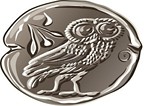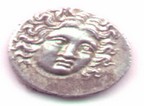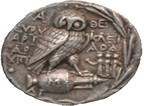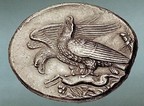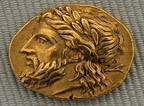The history of the currency
Money is used in all seasons in all directions and for all purposes. Its acquisition was for centuries one of the main aspirations of people. The coins are a basic unit of money. Currencies were changed, altered, adapted to the specific changes that led to or caused by different social, economic and historical conditions.
The first coins were made in Asia from electrum, an alloy of gold and silver at the end of the 7th century. The precious metal gave it the value, the small format made it easy to carry, the symbol of each issuing authority, which was added later, was giving the guarantee of the coins weight and authenticity.
The Greek cities spread the use of currency from Spain to the Black Sea. They used their symbols, heroes, gods, animals, plants, etc., to mark the coins. They minted silver coins mainly because that was the precious metal at which had easier access. At the end of the fifth and especially the 4th century and bronze coins were released for small everyday transactions.
King Philip II popularized the use of gold coins and had access to gold mines of Mt. Paggaio. After the death of Alexander III rulers and kings of started to be depicted in the coins of each area. The depiction of the sovereign emperor is the main theme of the iconography on Roman imperial coins from the first BC up to fourth AD century.
The Roman coins were spread throughout the known world and minted in gold, silver and copper. In the Byzantine legal currency other than the Emperor the display of the divine, the Christ, the hand of God, Christian symbols, were added and representations were made on the obverse of the coin. The “One God and one emperor” of the Byzantine conception of the world was depicted on coins.
The Byzantine gold solidus prevailed from the 4th to the 11th century in the Eastern Mediterranean and far beyond it. In Western Europe, gold coins followed the standards of Roman and Byzantine coins. From the 13th to the 15th century, the Venetian currency would prevail in this area. In Europe, gold forints of Florence will be the basis of trade during the 14th century.
Before the currency
Before currency, the commodities exchange, barter was the most widespread practice of ensuring the basic needs of people. The barter is very old and in some sense, some elements seem to exist in nature, plants, insects and animals where shared services and resources to ensure the survival of species and to maintain environmental balance.
Transactions in kind facilitated the first human societies to survive. Agricultural food products, leather, animals, shells were the accepted transaction. The most valuable was the rarest. Depending on the abundance, the usefulness and role of each product in every society and determined its price. With the installation of a permanent human dwelling, the economy was based on farming. Mostly animals were used as a medium of exchange. In the Iliad the bronze weapons of Diomedes worth 9 oxen and the golden ones of Glaukos were worth 100 oxen.
The rich man was called polyvoutis (That has many cows), the landless avoutis. Even today, this translates into many languages. Latin caput voskimatos means head and from there comes the word capital (Capital) and capitalism. Pecus means bred, the voskimata and from there comes the term pecunia (Property, money).
With the discovery and diffusion of metals, a new medium of exchange was added along with the animals. The use of metal to trade witnessed since the late third millennium BC Mesopotamia. Inscriptions suggest laws, payments, contracts were weighted based on silver, sometimes in combination with barley or other cereals.
Over the years, metal prevailed in trade and other areas. In Egypt, at the end of the second millennium mentioned metals weighed to constant weights to calculate the value of a product group. Here it was possible to calculate payments in copper (1 ntempen = 91 g
In Greece during the second millennium BC talents appear to be used as a medium of exchange (metal plate shape), for many scholars, this represents a stretched ox hide, and for others they were just more convenient to carry. Talents have been found in various parts of the Mediterranean basin to the south coast of Asia Minor, Sardinia, Cyprus, at Mycenae , the Cyme, Crete and other islands.
The first coins
At the end of 8th and early 7th century BC, even a utilitarian object, an iron spit (rotisserie grilling) was used as a medium of exchange. Six spits, those words fit to hold the hand of man, had a value of the drachma (= I take hold, palm handful => penny).
The spit as a medium of exchange is attributed by some scholars to the king of Argos Pheidon. It was he who introduced the use of metal as a currency in the form of spit.
The use of spit was widespread for practical reasons and for that prevailed immediately as a medium of exchange. Was both practical instruments to use, as were used for firing the animals, but also monetary, if successfully remedied in the previous transaction. The thickness of each spit was such, that one hand could hold one 6 spits the same time. From “embracing – DRAX” (= catch hold, I find, I keep) came the word “penny”, which continued for so many centuries is the monetary unit of the Greeks.
The invention of currency was a matter of time. The experience in metal trading and standardization of various shapes easily led to the currency. Its small size allowed for easy transportation. Sealed by the responsible authority, the value was given and there was no longer the need of weighing. The generalized use of the currency however, was slowly spread.
The first coins were minted in the kingdom of Lydia and the Greek cities of Asia Minor, in Ionia, shopping areas and economically developed in the late 7th BC century. Their material was electrum, an alloy of gold and silver. Their shape was oval and on their one side they had irregular indentations.
The “treasure” found in the foundations of the temple of Artemis at Ephesus in 1904/5 were of electrum coins, jewelry and other valuables. The hoard contained coins from cities of Lydia and the Greek coast of Asia Minor. Hiding deemed to have been between 600-560 BC. This finding greatly helped in dating of the first coin. The islands in the Aegean Sea started minting coins soon…
